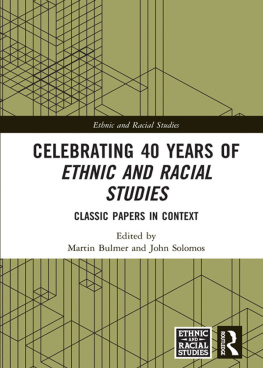Routledge Revivals
Working-Class Images of Society
First published in 1975. How does man come to perceive and evaluate a world in which marked inequalities of class and status exist? This book considers the nature of class images and their underlying work and community structures. Beginning with the argument that the perception of society varies according to type of work and community milieux, it first considers the social imagery of working-class professions and their sources of variation, and then examines some of the methodological problems of the study of class imagery. The nature of proletarian traditionalism and radicalism in then contemporary Britain is discussed in conclusion. This title will be of interest to students of sociology.
Working-Class Images of Society
Edited by
Martin Bulmer
First published in 1975
by Routledge & Kegan Paul
This edition first published in 2016 by Routledge
2 Park Square, Milton Park, Abingdon, Oxon, OX14 4RN and by Routledge
711 Third Avenue, New York, NY 10017
Routledge is an imprint of the Taylor & Francis Group, an informa business
1975 Routledge & Kegan Paul Ltd
All rights reserved. No part of this book may be reprinted or reproduced or utilised in any form or by any electronic, mechanical, or other means, now known or hereafter invented, including photocopying and recording, or in any information storage or retrieval system, without permission in writing from the publishers.
Publishers Note
The publisher has gone to great lengths to ensure the quality of this reprint but points out that some imperfections in the original copies may be apparent.
Disclaimer
The publisher has made every effort to trace copyright holders and welcomes correspondence from those they have been unable to contact.
A Library of Congress record exists under LC control number: 75332962
ISBN 13: 978-1-138-90823-9 (hbk)
ISBN 13: 978-1-315-63711-2 (ebk)
ISBN 13: 978-1-138-63955-3 (pbk)
WORKING-CLASS IMAGES OF SOCIETY
edited by
MARTIN BULMER
ROUTLEDGE DIRECT EDITIONS
ROUTLEDGE & KEGAN PAUL
London, Henley and Boston
in association with the
SOCIAL SCIENCE RESEARCH COUNCIL
First published in 1975
by Routledge & Kegan Paul Ltd
39 Store Street,
London WC1E 7DD,
Broadway House, Newtown Road,
Henley-on-Thames, Oxon RG9 1EN and
9 Park Street,
Boston, Mass. 02108, USA
Manuscript typed by Betty R. Ozzard
Printed and bound in Great Britain
by Unwin Brothers Limited,
The Gresham Press, Old Woking, Surrey
A member of the Staples Printing Group
Reprinted 1976
Routledge & Kegan Paul Ltd 1975
No part of this book may be reproduced in any form without permission from the publisher, except for the quotation of brief passages in criticism
ISBN 0 7100 8308 4
CONTENTS
Martin Bulmer
David Lockwood
Robert S. Moore
Jim Cousins and Richard Brown
Colin Bell and Howard Newby
Roderick Martin and R.H. Fryer
Eric Batstone
R.M. Blackburn and Michael Mann
Martin Bulmer
Alfred Willener
R.L. Davis and Jim Cousins
D.H. Allcorn and C.M. Marsh
Graeme Salaman
David Lockwood
J.H. Westergaard
David Lockwood
The study of working-class social imagery is a field which was established early in the development of British sociology. The idea of a conference which would bring together a variety of more recent research and theory on the subject originated with Mr Martin Bulmer, and was recommended for support by the Sociology and Social Administration Committee of the Social Science Research Council (SSRC). The conference took place at Durham in September 1972, and this edition of the papers has been prepared by Mr Bulmer, to whom all credit is due. It does not necessarily represent any agreed view of the SSRCs Sociology and Social Administration Committee or of the Council itself. Grants made by the SSRC for studies connected with working-class social imagery are referred to in the Preface.
Jeremy Mitchell
Secretary, Social Science Research Council
The papers on working-class social imagery appearing in this volume were originally presented to the SSRC Conference on The Occupational Community of the Traditional Worker (referred to in Mr Mitchells Foreword), which was held at Van Mildert College, Durham from 25 to 27 September 1972. The subject of the conference was recent and current British research on social imagery and subjective perceptions of social stratification among those in traditional working-class occupations. Professor David Lockwoods article entitled Sources of Variation in Working-Class Images of Society (first published in the Sociological Review, vol.14, no.3, November 1966, pp.24967 and reproduced by permission) provided the thematic focus of the conference.
The papers which follow are divided into four groups. In is reprinted Lockwoods 1966 paper, containing the influential ideal types of the proletarian traditional worker and the deferential traditional worker. This paper is the starting point for all the others in the symposium. It is preceded by a short Introduction setting the article and the debates around it in a broader sociological context.
contains six papers reporting the results of empirical research on manual workers perceptions of the class structure. Two of these papers - by Moore on coal-miners and Cousins and Brown on shipbuilding workers - are concerned with occupations which Lockwood linked to the existence of traditional proletarian images of the class structure. Three of these papers - Bell and Newby on agricultural workers, Martin and Fryer on textile workers, and Batstone on workers in small firms in Banbury - are concerned with occupations or work milieux which Lockwood linked to the existence of traditional deferential images of the class structure. The sixth paper, by Blackburn and Mann, analyses the results of a survey conducted among a sample of non-skilled manual workers in a range of industries in the town of Peterborough, and examines the genesis and nature of workers social imagery from a rather different standpoint.
In are several papers considering more general theoretical and methodological issues. As an introduction, the editor discusses a number of methodological problems associated with the study of class imagery. This is followed by a paper by Willener (a pioneer of the study of class imagery in the 1950s) in which he makes several valuable distinctions between different types of imagery, and raises questions about the contexts of research and action in which imagery is elicited. Davis and Cousins direct attention to the historical dimension (with what state of affairs is the social imagery of contemporary traditional and affluent workers being compared?) and to the status of ideal-type analysis. Both Salaman and Allcorn and Marsh discuss from different standpoints the status of the concept occupational community, which Lockwood identified as supporting in particular traditional proletarian imagery of the class structure.
In Lockwood comments on the preceding papers in the light of the original article, and replies to his critics. This is followed by a comment by Westergaard on radical class consciousness, and a postscript by Lockwood on the radical worker which rounds off the symposium.




